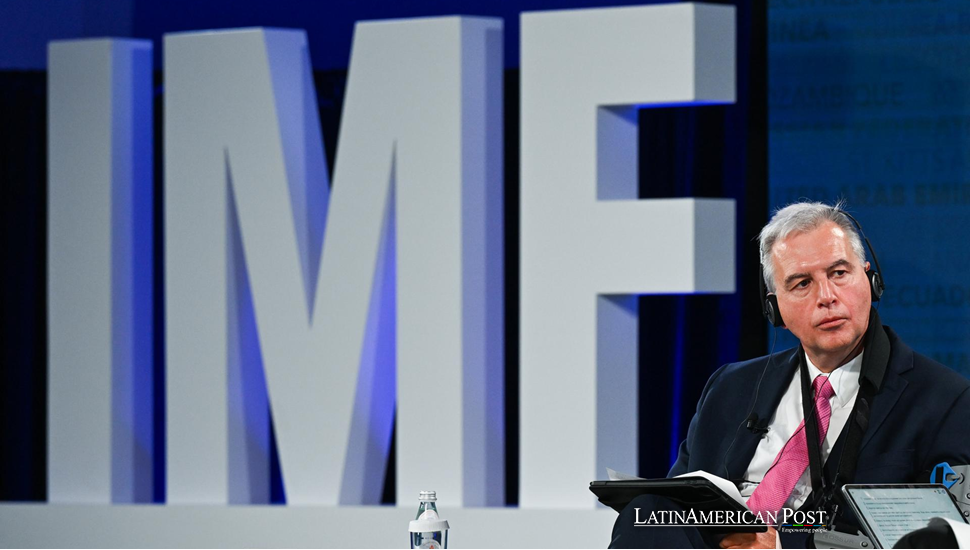IMF Raises Latin America and Caribbean Growth Forecast for 2024

The International Monetary Fund (IMF) has revised its 2024 growth forecast for Latin America, projecting a 2.1% increase in GDP, with Brazil leading the way at 3.0% growth. However, Mexico’s outlook has been downgraded, reflecting contrasting economic momentum across the region.
Brazil’s Economic Momentum Fuels Growth Forecast Increase
The International Monetary Fund’s (IMF) latest revision of its 2024 growth forecast for Latin America highlights Brazil’s robust economic performance. The IMF predicts Brazil’s economy will grow by 3.0% in 2024, significantly from its previous estimate of 2.1%. This optimism stems from stronger-than-expected private consumption and investment during the year’s first half, bolstered by a tight labor market and government transfers to stabilize household incomes.
Brazil’s growth momentum has also been supported by a relatively smooth recovery from floods that earlier threatened to disrupt the economy. The IMF noted that the damage from these natural disasters was less severe than anticipated, allowing economic activity to resume quickly. As a result, consumer spending surged, helping to fuel Brazil’s positive economic outlook for the coming year.
Moreover, the Brazilian government’s fiscal policies have played a key role in driving growth. Public investment in infrastructure and support for social programs have increased disposable incomes and consumer confidence. The labor market remains tight, with unemployment at its lowest level in years, further boosting private consumption and contributing to the country’s growth trajectory.
However, the IMF has warned that inflation remains a concern for Brazil. Despite the growth in private consumption, rising prices have prompted the Brazilian Central Bank to continue tightening monetary policy. Although stabilizing, the country’s inflation rate remains higher than desired, and further efforts to contain price increases will be required. The bank’s cautious approach to monetary policy signals that it aims to prevent overheating the economy while sustaining growth.
Brazil’s strong 2024 forecast is a bright spot in the region, offering hope that Latin America’s largest economy can continue to weather global economic uncertainties and support regional stability. The country’s focus on investment and consumption has proven effective, setting a positive example for other nations seeking to boost their growth prospects.
Mexico’s Revised Outlook
While Brazil’s economic outlook brightens, Mexico’s forecast is more cautionary. The IMF has revised Mexico’s 2024 growth projection to 1.5%, a sharp drop from the 2.2% previously estimated in July. This downward revision reflects weaker-than-expected domestic demand, which has slowed the country’s economic recovery.
Mexico’s economy, closely tied to the United States through trade and investment, has been hit by a slowdown in consumer spending and business investment. The IMF attributed the decline in growth expectations to a combination of factors, including higher interest rates, dampening borrowing and investment, and a general softening in domestic demand as inflation continues to eat into household purchasing power.
The rising cost of living has created challenges for Mexican consumers, particularly those in the lower and middle-income brackets, where inflation has had the most significant impact. As prices for essential goods such as food and energy rise, families have been forced to cut back on discretionary spending, slowing the overall economy. Despite the inflationary pressures, the IMF expects Mexico’s central bank to begin easing its monetary policy as inflation stabilizes.
Mexico’s economic ties to the U.S. have also introduced uncertainty into its growth outlook. While trade with the U.S. remains solid, potential shifts in U.S. fiscal and monetary policy could impact Mexican exports and industrial production. As the U.S. navigates its economic challenges, any slowdown in its growth could have ripple effects on Mexico’s economy, further affecting demand for Mexican goods.
In response to these challenges, the Mexican government has announced plans to stimulate the economy through public investment and infrastructure projects. These efforts aim to boost employment and create new growth opportunities. However, the IMF remains cautious about these measures’ overall impact, noting that Mexico’s economy will likely continue facing headwinds soon without a significant increase in domestic demand.
Argentina’s Economic Struggles Persist Amid Broader Regional Stability
Argentina stands out among Latin America’s major economies for its economic difficulties. The IMF projects that Argentina’s economy will contract by 3.5% in 2024, following a 1.6% decline in 2023. This marks a sharp downturn for the country, which has been grappling with economic instability, high inflation, and political uncertainty for several years.
The IMF’s outlook for Argentina highlights several structural challenges that have hindered the country’s growth. Chief among these is runaway inflation, which has eroded purchasing power and made it difficult for businesses to operate effectively. With inflation rates exceeding 100% in some sectors, living costs have skyrocketed, leading to widespread discontent and social unrest.
Argentina’s economy has also been hit hard by a lack of foreign investment and limited access to international credit markets. The country’s ongoing negotiations with the IMF over debt repayment have further complicated its economic recovery efforts. Despite government attempts to stabilize the currency and reduce inflation, these efforts have been largely unsuccessful, leading to a prolonged economic slump.
However, the IMF remains optimistic about Argentina’s long-term prospects, projecting a solid rebound in 2025 with 5.0% growth. This forecast assumes that political stability will improve following the country’s upcoming elections and that inflation will moderate as the government implements more effective fiscal policies.
In the short term, though, Argentina’s economy faces significant challenges. If it hopes to reverse the downward trend, the government must focus on stabilizing inflation, improving investor confidence, and creating an environment conducive to growth. Argentina remains an outlier in an otherwise stable regional economy with uncertain recovery.
Latin America’s Path to Recovery by 2025
While the IMF’s forecast for Latin America and the Caribbean in 2024 reflects mixed fortunes across the region, there is hope for broader recovery by 2025. The IMF projects that the region’s growth will accelerate to 2.5% in 2025, driven by improving economic conditions in Brazil, Mexico, Argentina, and other countries.
Brazil is expected to maintain its growth momentum, with private consumption and investment continuing to drive the economy. The IMF also anticipates that inflation will moderate in Brazil as monetary policy measures take effect, allowing for more sustainable growth in the long term.
While facing short-term challenges, Mexico is also expected to see an improvement in its growth prospects by 2025. As inflation eases and domestic demand recovers, the country’s economy is likely to benefit from increased trade and investment flows, particularly from its close economic ties with the U.S. Additionally, Mexico’s focus on infrastructure development and public investment could create new opportunities for growth in key sectors such as manufacturing and energy.
Argentina’s projected rebound in 2025 is perhaps the most striking element of the IMF’s forecast. If the country can successfully implement the necessary economic reforms and stabilize its inflation rate, it can regain some of the economic momentum lost over the past few years. A return to growth would benefit Argentina and contribute to the region’s overall stability.
The IMF’s overall outlook for Latin America and the Caribbean is cautious optimism. While the region faces several challenges, including inflationary pressures, political instability, and global economic uncertainty, there are clear signs that recovery is possible. The key to success will be maintaining fiscal discipline, promoting investment, and addressing structural issues that have long hindered economic growth.
Also read: Mexico’s Industrial Parks Boom As Nearshoring Surges
While the IMF’s latest forecast highlights the divergent paths of Latin America’s major economies in the short term, the region is poised for recovery by 2025. As Brazil leads the way with solid growth, Mexico and Argentina must address their respective challenges to ensure they can also benefit from the broader regional recovery. With the right policies in place, Latin America has the potential to emerge from this period of uncertainty stronger and more resilient than before.





